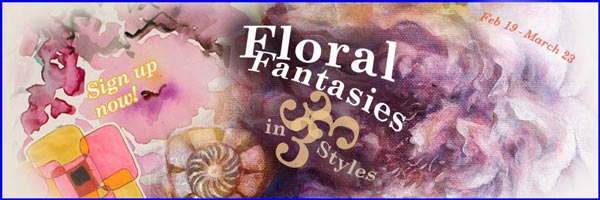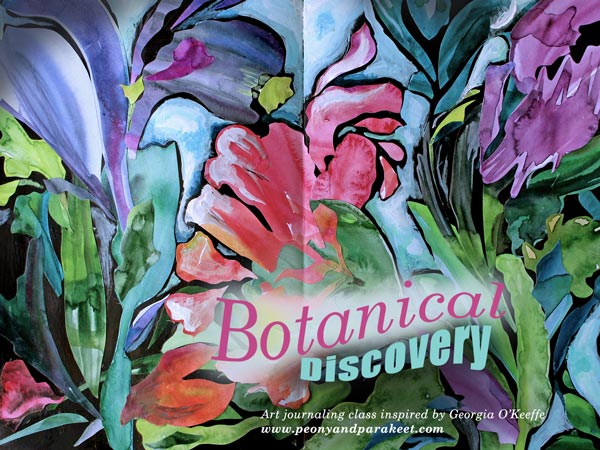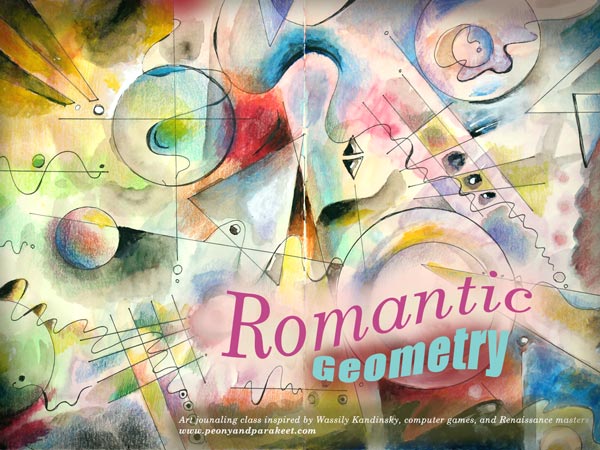Flower Art Inspiration from the Students of Floral Fantasies
Today, you will see beautiful art from the students of Floral Fantasies in Three Styles!
In this online workshop, you play with three different approaches and pick the best from each of them.
Week 1 – Designs to Spark the Imagination
I think we all have browsed Instagram or Pinterest and found inspiring images from illustrators and pattern designers. In the first week, I show how to use flower photos to create simple designs that still look lively and unique. You will build designs from simple shapes and get inspiration from art nouveau, art deco, mid-century modern, and Scandinavian retro.
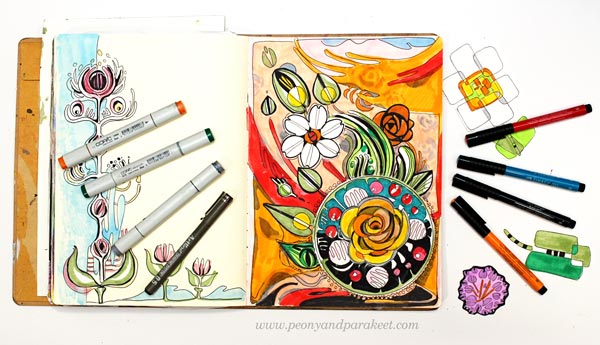
What I love about the students’ designs, is that they are all so original and express personality as well. I have included my favorite detail in the images.
Stephanie Carney:

Cathy Cale:
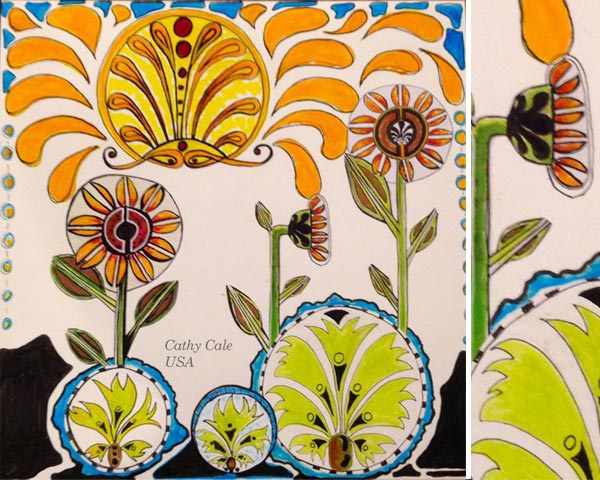
Diane Williams:
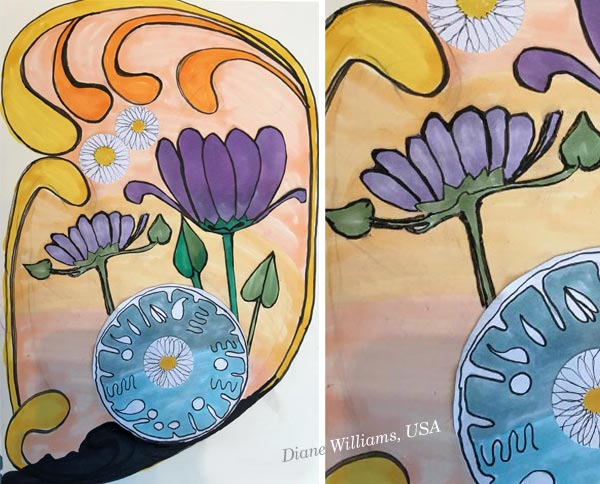
Jenny Baeta:
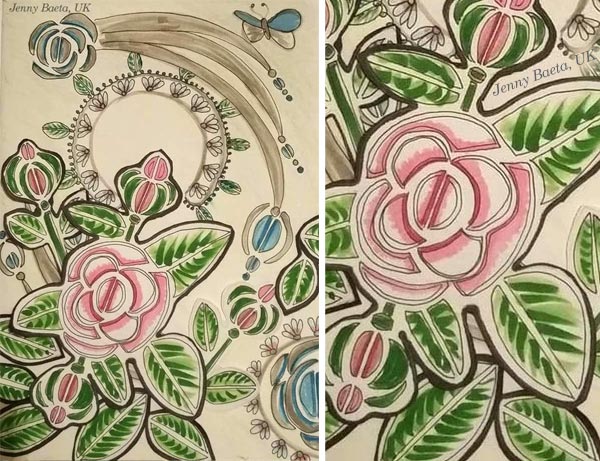
Gill Turner:
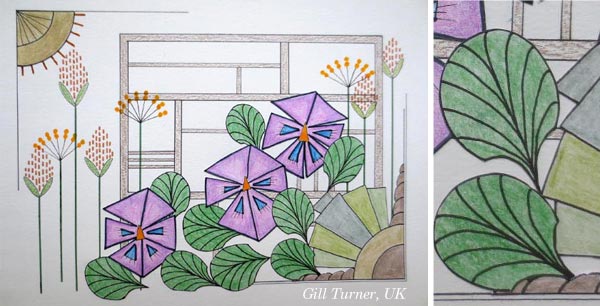
Nancy Kvorka:
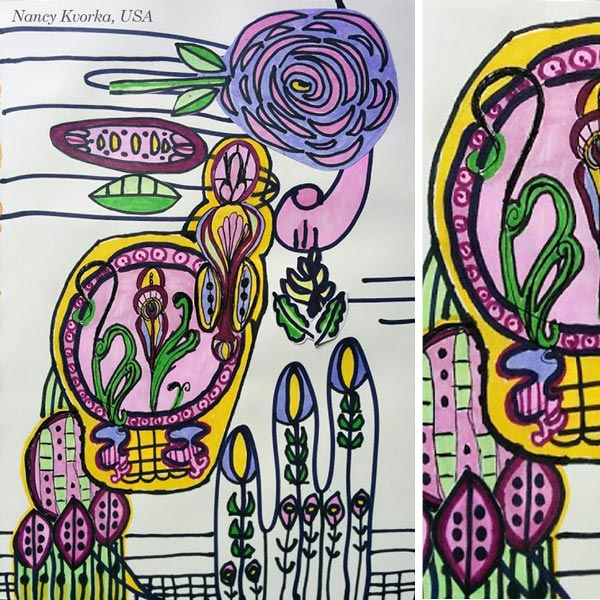
Week 2 – Watercolors to Bring Up Expression
In week 2, we go to a different direction but use the idea of simplifying as a foundation for painting intuitively. The best media for quick, intuitive painting is watercolors, of course!
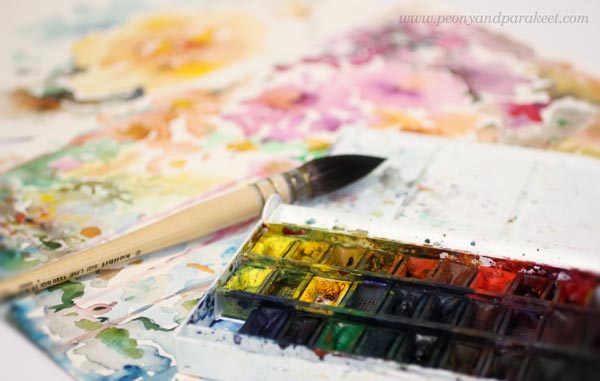
Tina Mitchell:
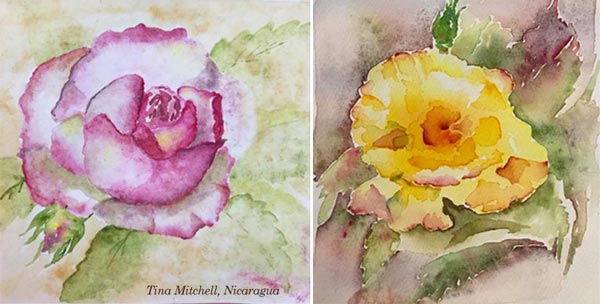
Darci Hayden:

Christy Tattersall:
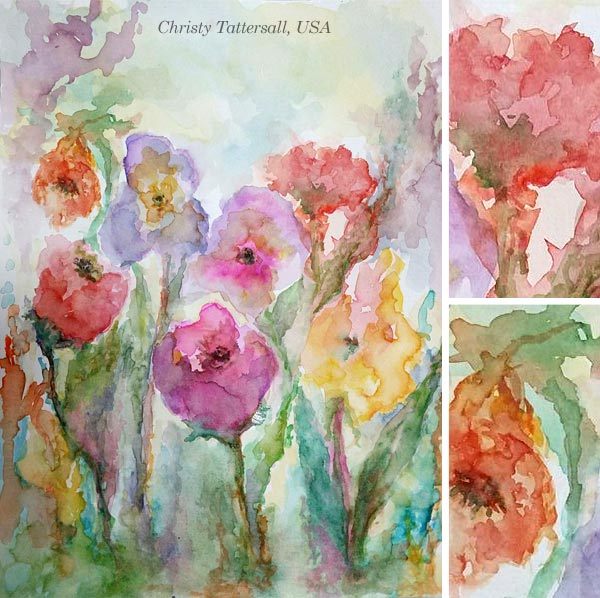
Wendy Holmgren:
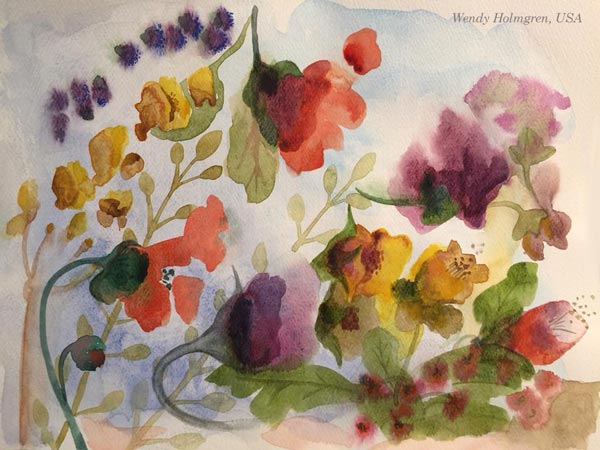
You can be less or more abstract when creating flowers with watercolors. You can adjust the theme to paint a still life, scene or landscape. See how Lisa Wright’s and Pirkko-Liisa Mannoja’s styles are different, yet both have their strengths.

There are so many different kinds of energy that you can express from quiet power to bubbling bursts, or maybe you want to splash boldly as Darci did in her piece.
Weeks 3 & 4 – Acrylics and Glazing Medium to Create Softness
In the next two weeks, we use all the things we have learned from watercolors as a new foundation for painting with acrylics. If you like to create quickly but get frustrated with the result, these weeks can be ground-breaking to you. Instead of rushing, you will calm down. You will see nuances and softness that you hadn’t noticed before. You will learn to use glazing medium so that it will make acrylic paints speak the language of flowers.
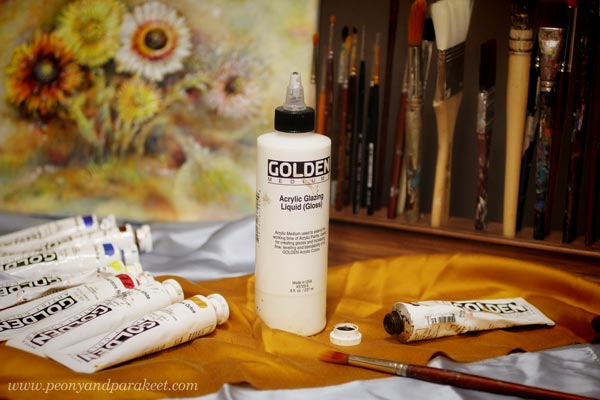
This old technique has many applications. You can use it for intuitive art, and it’s especially good for figurative painting. Practically most of the old pieces from the 16th to the 18th century use the technique with oil paints. I have adapted the technique to acrylic paints. I also have experience in oil painting so I can give you some tips if you prefer oils instead. These pieces created by students are made with acrylics and glazing medium.
The first layers are painted with umber and white. It’s called underpainting. Martha Winslow shows you an example of that:
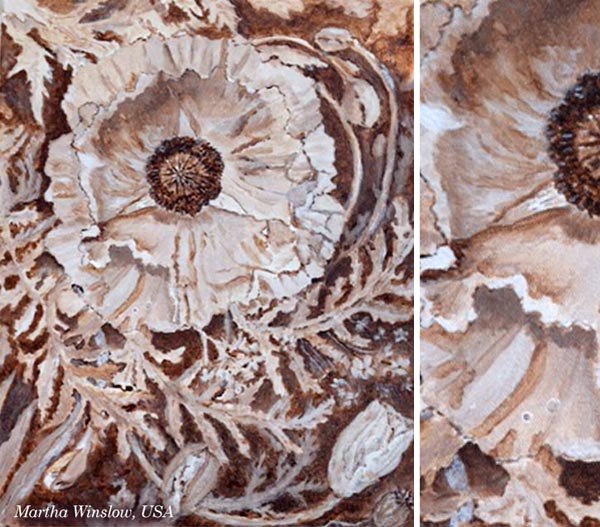
Mackie d’Arge’s underpainting and the painting after some color layers:
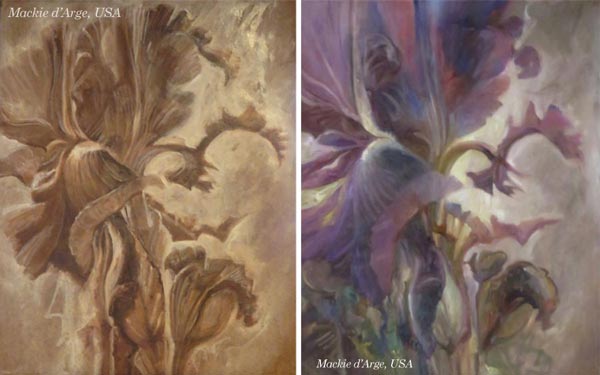
Susana Trew shows the softness I talked about earlier:

Leena Meinilä’s piece shows the romantic approach with glowing details that was popular in Renaissance:
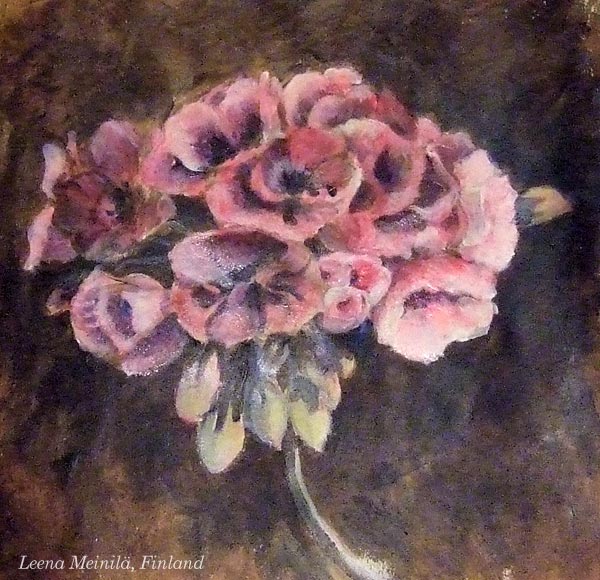
Marie Jerred shows how you can still play with colors even if you are painting like old masters:
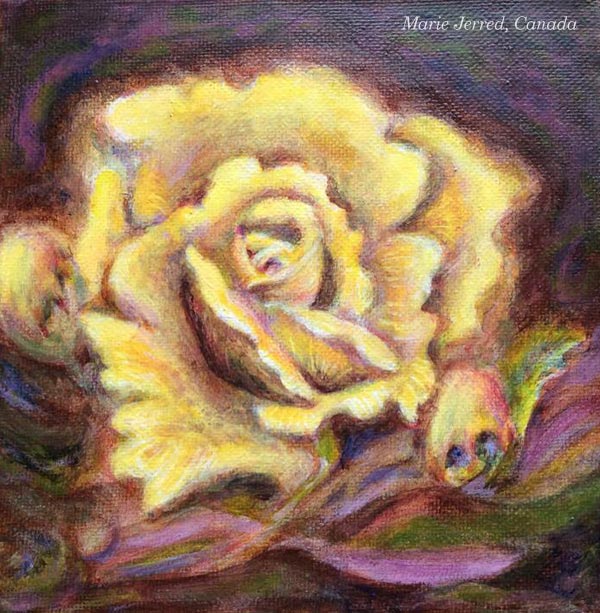
Paula Snyder said about the class: “The old masters portion was earth shaking for me. Really good material I’ll use all my life. I feel like I am turning a corner in my artistic growth.”
See how her painting is full of delicacy in shapes and colors, and still so captivating in simplicity.
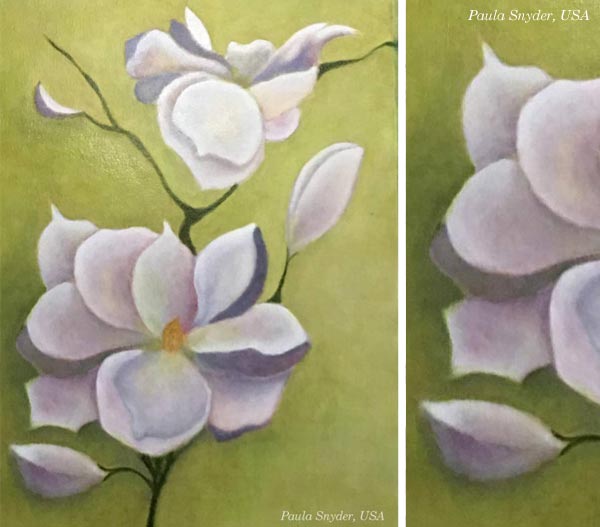
Many contemporary painters use this old technique, especially the underpainting part. It helps you to get away from the flat look, and bring depth and 3-dimensional impression to your work. Wendy Holmgren’s flower is a beautiful example:
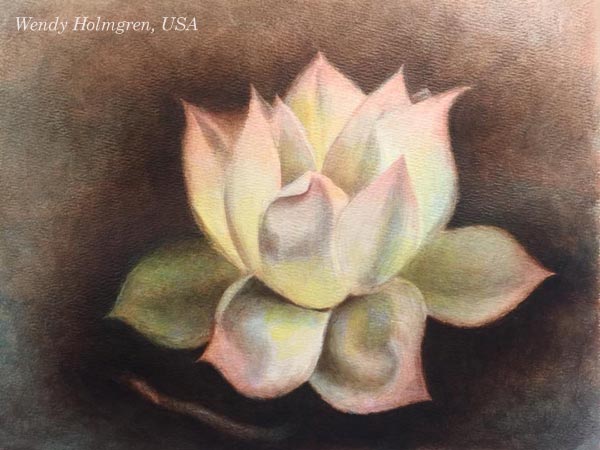
Marion Berkhout said: “I found a way of working which I didn’t expect at all. And it gave me the confidence to trust myself in art. The class gave me the opportunity to develop myself as an artist and learn new skills.”
Marion’s painting takes the old technique to the contemporary era:

Come and Create Your Floral Treasures!
Floral Fantasies in 3 Styles begins on Feb 19th, and the early-bird registration closes this week. Get the reduced price – sign up now!
More Art Inspiration – Join the Free Webinar too!
Tomorrow, I will broadcast live from my studio in Finland and talk about finding your visual voice. Welcome to the webinar! >> Save your spot here
The webinar will be recorded. If you save your spot, you can also watch the replay later!
Loving Vincent and Purchasing Oil Paints
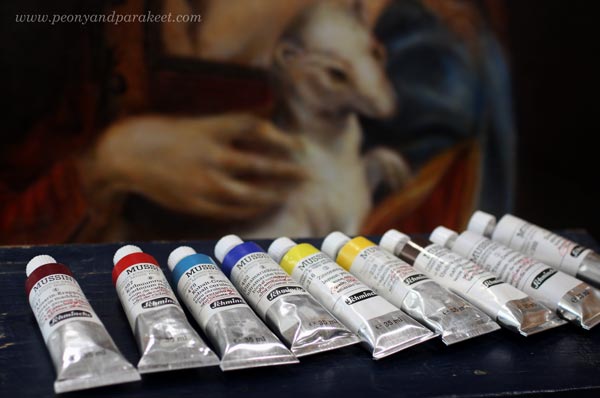
Yesterday, I opened the door of a local art supply store and headed to a specific shelf. On my way to the store, when walking on the narrow streets in the center of Helsinki, I felt it. The feeling that I got a year ago when I opened a tube of Mussini oil paint for the first time. I was attending an art class about old masters painting techniques, and we used the best oil paints I could imagine. Not that I could imagine so much because I had never used oil paints before. But I didn’t expect to experience that strange feeling. It contained both appreciation and excitement. The appreciation of color, and the excitement to learn more from it.
It was not that I would have been new to color. I had been painting with acrylic paints for a long time. When I was a teenager, I got them from my parents who thought that it was a perfect solution to me. No worrying about toxic painting fluids and still being able to paint with ease. The acrylic paints have developed a lot since that time, since the eighties. They have worked perfectly for my needs. I have found a good brand too. I really like Golden acrylics.

But now I was standing in the front of a vast collection of Mussini oil paint tubes. I picked the color chart and went through my choices one more time. For a whole year, I had been going through this in my mind: raw umber, zinc white, titanium white, yellow ochre and so on. It had been a mantra that changed a little bit every month. The paints are expensive, and I had to pick the colors carefully. One tube can cost more than 70 euros.
Plan for the Hand and Mind
After trying out the paints for the first time, I went to live in denial. Yes, I had painted the class pieces with oils because they were provided by the class. But the odorless and water-soluble acrylics felt much more suitable for me. After a while, my attitude changed a bit. I let myself dream about the oil paints. I visited the art supply store, touched the clean and shiny tubes, imagined getting just a bit of paint on a palette and make it last for as long as possible.
But dreaming and reality are surprisingly close. It’s difficult just to dream and not to do anything. So I made a plan that felt more like extortion. I had to get my floral painting class finished. I had to get several acrylic paintings finished. I had to figure out where and how I would store the paints. I had to get more information about the oil paints and the painting liquids.
I still had some finishing touches to do for my paintings in progress, but other than that I had followed the plan. So I started picking the tubes: raw umber, zinc white, titanium white, yellow ochre and so on. After selecting the colors, I went for the liquids: poppy oil, turpentine, and glossy dammar varnish.
When I left the store, my mind summarized the past year. Learning the old masters’ techniques had been essential for growing my technical skills. My art had become less imaginative, and more conventional.
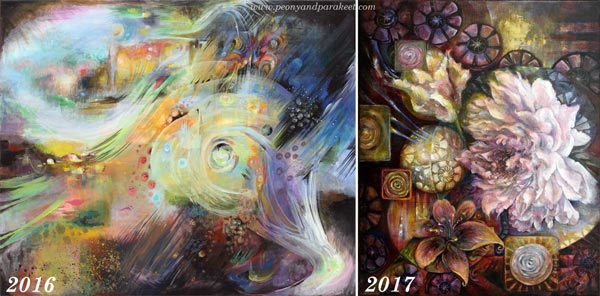
I had a turning point in 2016 when I felt that my imagination and my hand didn’t function so well together anymore. My imagination wanted to proceed to new territories, but my hand couldn’t follow. But now when my hand is wiser, I can also challenge my mind more freely. Purchasing the oil paints were a reward for the persistence that I have had for the last twelve months. However, it wasn’t the only reward. I was also going to see the new movie Loving Vincent.
Loving Vincent – The Movie
The movie theatre was about 10 minutes walk away from the art supply store. When I arrived, there were several queues for the tickets. I joined one. While I was waiting for my turn, a young man suddenly came to me and asked: “Do you want a free ticket? I have two, and my friend wasn’t able to come.” I happily accepted it and thanked the man. “Is this a sign?”, I asked myself. “Is this the final sign that I should do this – go forward, open the tubes, start painting my newest, odd ideas?” I don’t believe in destiny so much, but at that moment, it felt like Vincent van Gogh was talking to me: “Do that, paint those ideas, just like I painted mine.”
I found the movie very emotional. Every time, I saw a familiar painting coming to live, tears came to my eyes. I realized that this movie had to be published now, not earlier. Vincent’s art has become so well-known during the past decades that it unifies us. Art that was odd for masses of the 19th century is understood by every one living the 21st century. It has become so familiar that it’s sometimes difficult to appreciate it. And still, we need to feel the togetherness that Vincent’s paintings can offer. They are like icons that make us stronger together.
Looking back helps us to move forward. As artists, we are all Vincent’s descendants. No matter how we paint, what technique we use, we know about modern art because of Vincent. We know more than the people of the 19th century, and that enables us to explore art to all kinds of directions.
Loving Vincent – Art from the Students
I want to celebrate Vincent by showing beautiful pieces made by my students. They are made from my class Selfie Fantasy that shows an adaptation of Vincent’s technique.
Christie Juhasz:
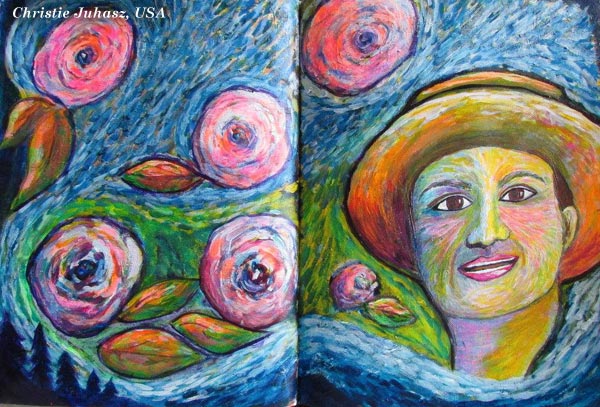
Terry Whyte:
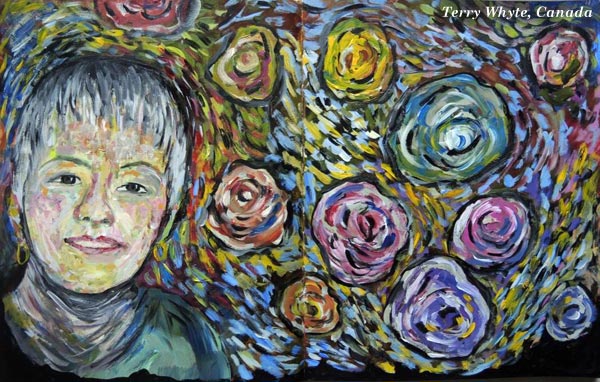
Denise Dineen:
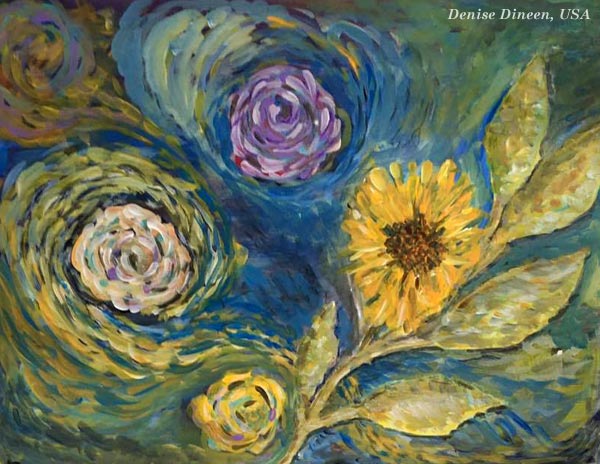
Gina Meadows:
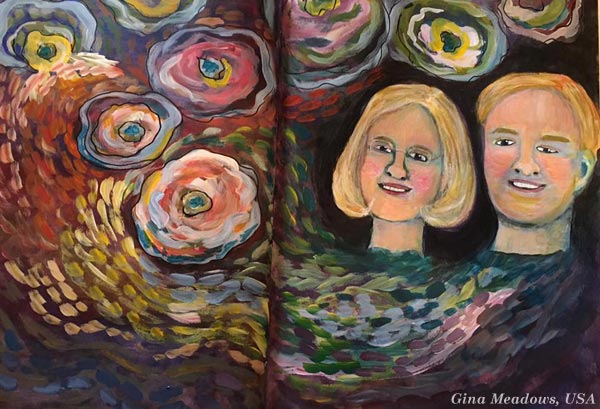
Patricia Furey:
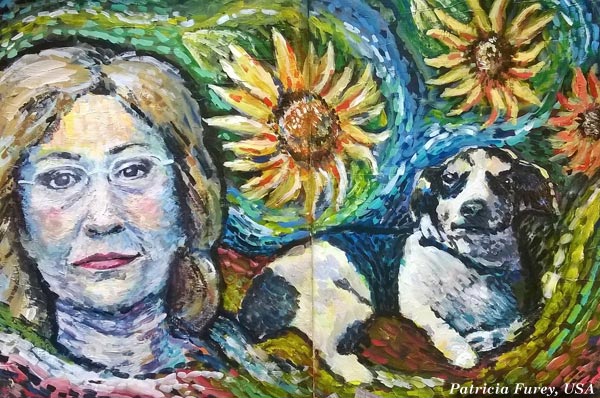
Stephanie Carney:
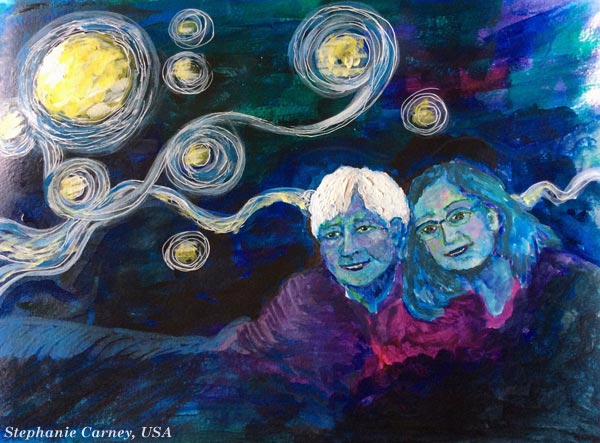
Have you seen the movie? What did you think about it?
Imagine Through Art – Buy 5 inspiring mini-courses! (including the Vincent-inspired one)
Klimt’s Garden with Students of Peony and Parakeet
We are heading for the winter in Finland. It has made me pull out the photos taken during the recent years from the garden. They remind me that the summer will come again. Together with my students, I dedicate this blog post for the famous Gustav Klimt (1862-1918) and the way he saw the world. It’s a perfect perspective when you want to get inspiration from the garden!
Portraits with Scenes Instead of Faces Only

Stephanie Carney shows so well how Gustav would see our gardens: full of decorative elements! This way of looking combines two perspectives. First, examining the details and their decorative nature. Second, seeing the big picture: how plants are not just individual and separate but integrated into a scene.
When browsing my photo library, I realized that I have a lot of close-up photos of flowers. But for this post, I picked images that show more than just ethereal petals. The images that have more than a few details make me more attached to my garden. I think it’s the same with paintings and drawings: instead of just sketching faces, we can show the whole experience.
That’s how Gustav Klimt built most of his portraits: not only focusing on faces but showing more of the world around the person by expressing it through decorative and abstract elements. Klimt’s mission was to combine decorative designs with fine arts, and I think it’s one of the reasons why his work is fascinating for us who like to sew, quilt, embroider, or do any crafts. When looking at Stephanie’s work, inspired by Klimt, I can easily imagine wearing that dress and stitching any of the beautiful motifs that can be picked from the picture!
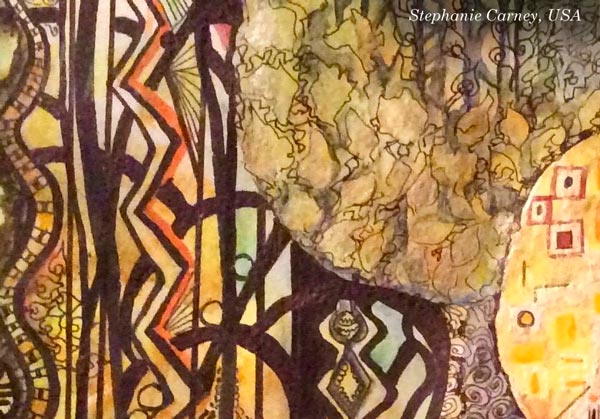
From Messy Garden to Klimt’s Garden
I claim that we can look at the garden using “everyday eyes” or “magical eyes.” When using the everyday eyes, everything is “should,” “could” or “have to.” We see weeds, neglected areas, messy grass. But with the magical eyes, we see nature as art.
For example, these ferns from my back garden horrified me when I looked at them with the everyday eyes. All I could see was a neglected flower bench getting ready for the cold weather. “I should cut those,” I thought. Then I took a step back and … wow! Nature had made an Art Deco pattern for me! I felt grateful and inspired. For a moment, I was in Klimt’s garden.
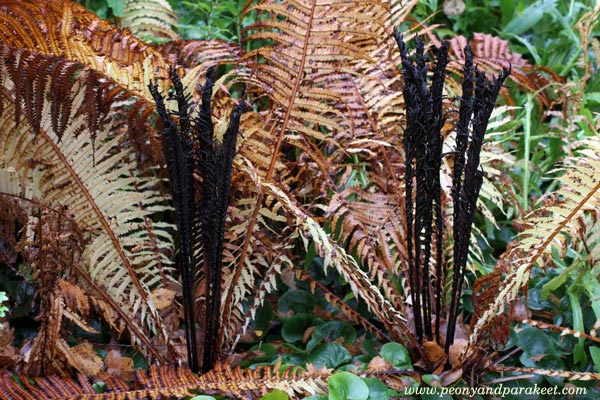
Gustav Klimt understood that when we want to express the beauty, we want to express the experience, not just copy what we see. When looking with the magical eyes – when being in Klimt’s garden, our feelings get mixed with the things we see, and nothing is fully organized. That’s why the sun feels more than just a bright spot in the sky in Lorraine Cline’s work. It doesn’t only make flowers grow, but it’s an uplifting force for humans as well. We get wrapped in its warmth, and for a moment, we are just one of the many plants in Klimt’s garden.
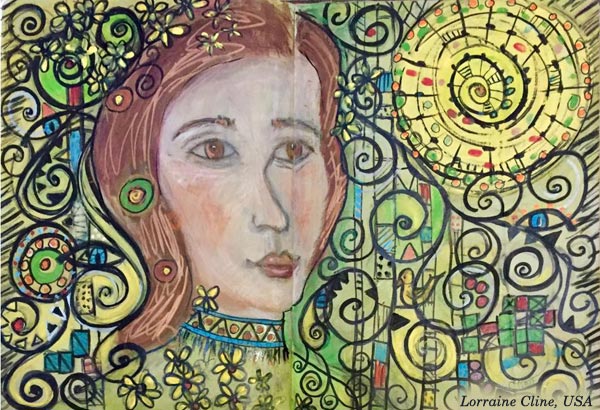
Quilted Garden
Gustav Klimt saw the world as a stream of patterns and colors. Sometimes they were symbolic, sometimes more literal like the artwork below, showing a baby’s quilt. Even if the painting is fine art, it honors crafts.
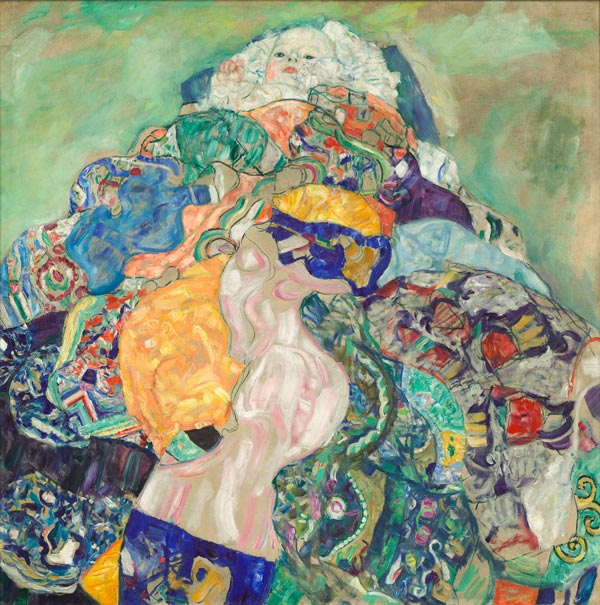
At Klimt’s garden, there’s no distinct border between nature’s and man’s creations. When you look at the world with the magical eyes, they become one.

Pirkko-Liisa Mannoja’s piece combines drawing and painting, but to me, it also looks like an art quilt.
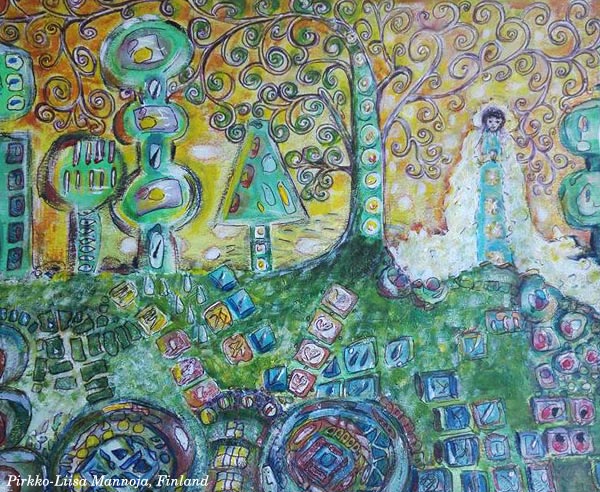
When we use the everyday eyes, we see the world as clearly-defined objects. We see green grass and red flowers. But when we look with the magical eyes, we see things that are more abstract, like the way the light forms spots in the background. That’s one of the subtle things that make Pirkko-Liisa’s work shine.
In Klimt’s garden, the grass can be white, and the observer can be green.
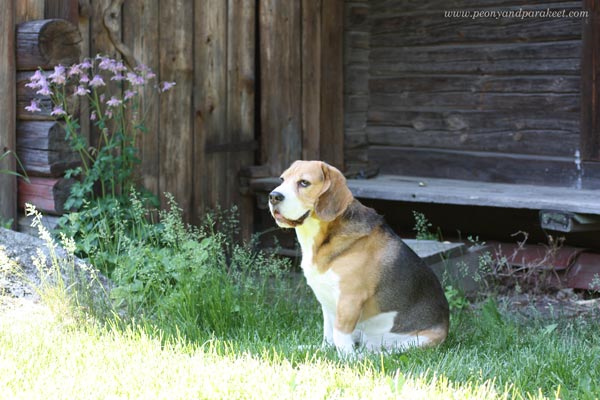
In Klimt’s garden, we treat trees like they were close friends. I love how Christie Juhasz expresses that in her beautiful art journal spread.
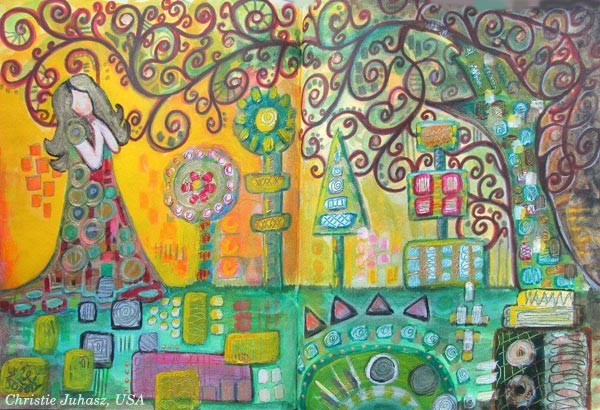
In Klimt’s garden, martagons take us back to Art Nouveau with their decoratively shaped stems and delicately colored flowers.
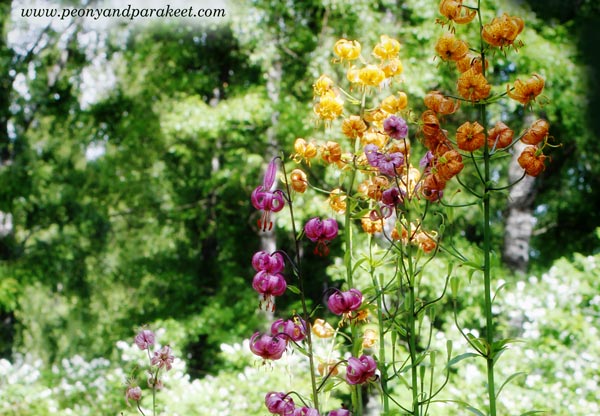
In Klimt’s garden, we connect with the outside world so that it lightens up our inner world. When I look at Mackie d’Arge’s gorgeous piece, I feel connected to both.
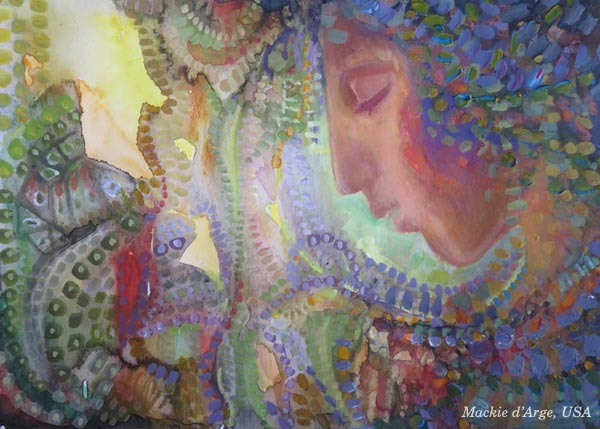
When we look at the world with the everyday eyes, we worry about the weather when we look up.
But when we change to the magical eyes, the sky and the earth are not separate at all. Just like in Diana Jackson’s expressive piece!
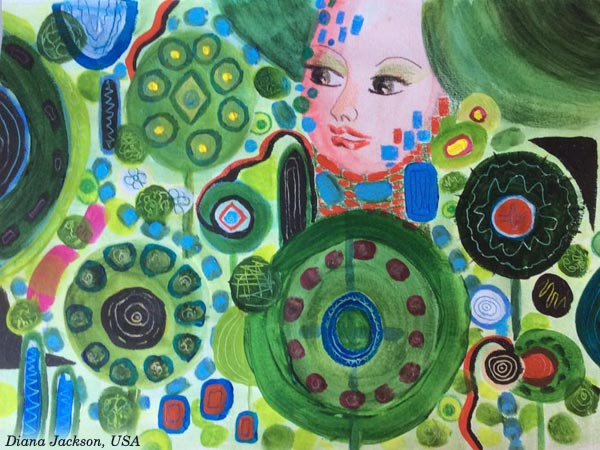
Winter in Klimt’s Garden
I wrote most of this blog post yesterday. When I woke up this morning, the snow had come to Finland. It felt depressing. “The garden is gone,” I said to myself. But then I realized that I had my everyday eyes. When looking with the magical eyes, Klimt’s garden is there for sure. It has just changed its colors.
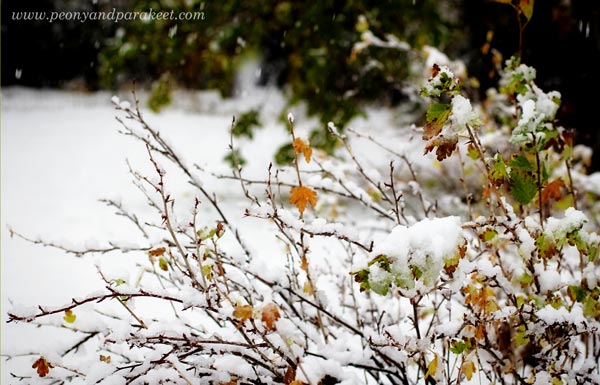
Klimt’s Garden in Your Art Journal!
The student artwork in this blog post is created from the mini-course Patterned Topiary. In the mini-course, you can create a decorative garden scene in Gustav Klimt’s style. The mini-course is available as a part of Imagine Monthly Fall 2016 art journaling bundle, packed with four more inspiring themes and techniques. And to celebrate the snow arriving in Southern Finland, you will get the generous 30% off during the weekend (from Oct 26 to Oct 29, midnight PST). >> Buy now!
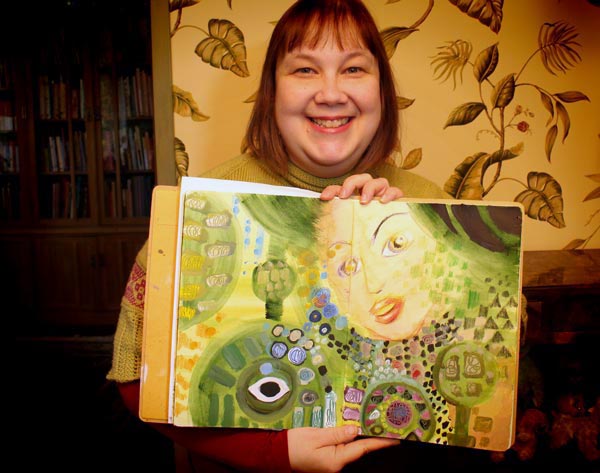
Create Klimt’s Garden: Buy Patterned Topiary + 4 inspiring mini-courses!
13 Prompts for Expressive Art – Illustrated by the Students of Peony and Parakeet

When you wonder what to create next, here’s a list of prompts for expressive art! Use these for art journal pages, drawings, paintings, mixed media, even for creative writing. The inspirational quotes from famous artists complement each of the short prompts. The students of Peony and Parakeet created the beautiful pieces that illustrate the prompts. They are based on the mini-courses “Botanical Discovery” and “Romantic Geometry.” These mini-courses are included in Imagine Monthly Art Journaling Class Bundle 2.
1) Living Colors
Claude Monet: “I perhaps owe having become a painter to flowers.”
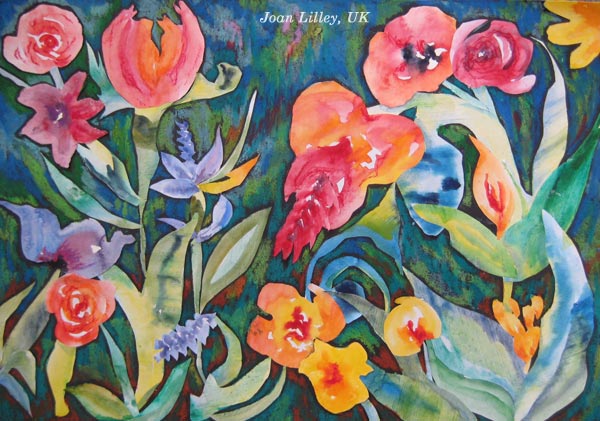
2) Dreamy Sharpness
Rene Magritte: “If the dream is a translation of waking life, waking life is also a translation of the dream.”
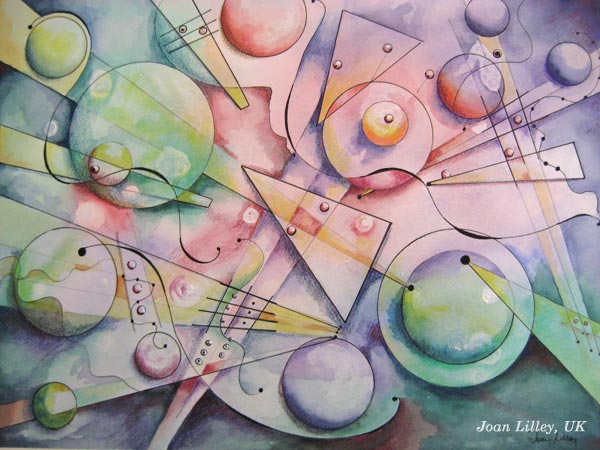
3) Speaking with Shapes
Vincent van Gogh: “The emotions are sometimes so strong that I work without knowing it. The strokes come like speech.”
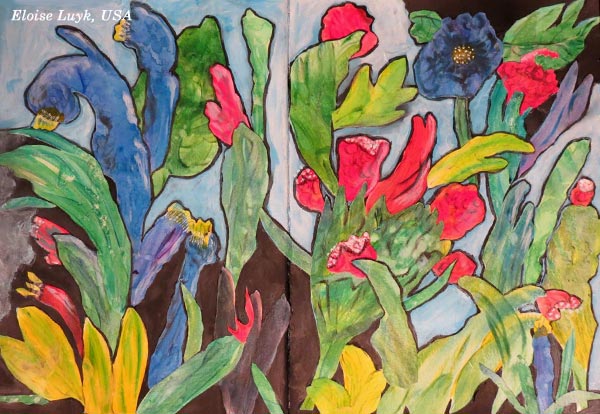
4) Composition of Absurdness
M.C. Escher: “Only those who attempt the absurd will achieve the impossible. I think it’s in my basement… let me go upstairs and check.”
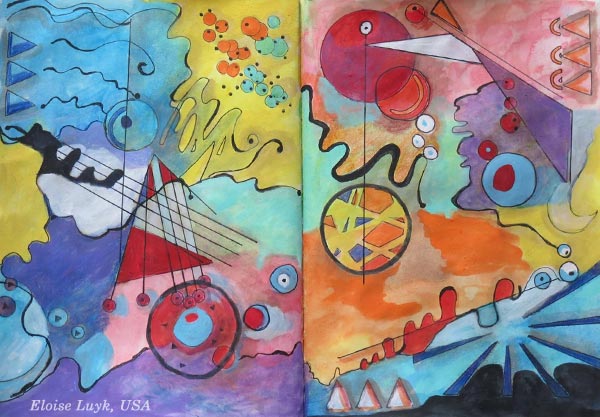
5) No Stereotypes!
Henri Matisse: “There is nothing more difficult for a truly creative painter than to paint a rose, because before he can do so he has first to forget all the roses that were ever painted.”
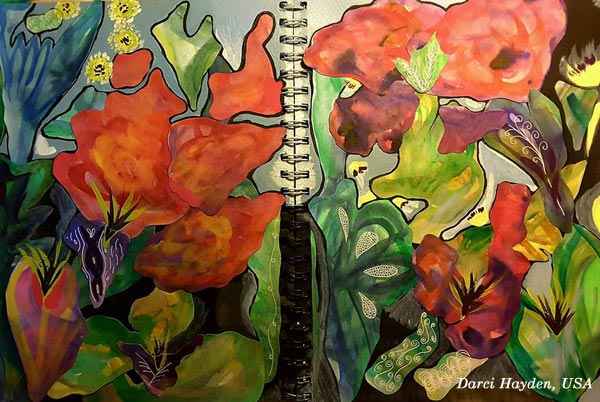
6) Bring in The Sun!
Pablo Picasso: “Some painters transform the sun into a yellow spot, others transform a yellow spot into the sun.”
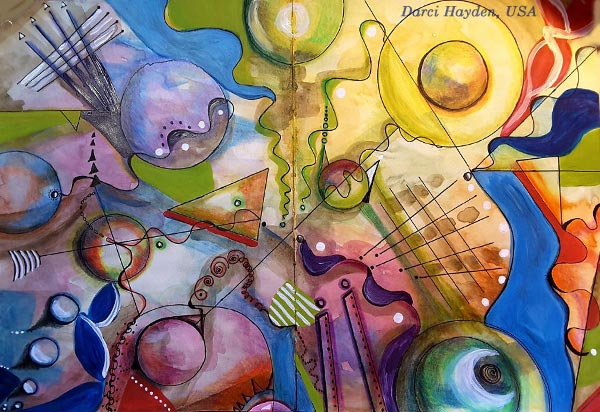
7) Taking Flight
Michelangelo: “I saw the angel in the marble and carved until I set him free.”
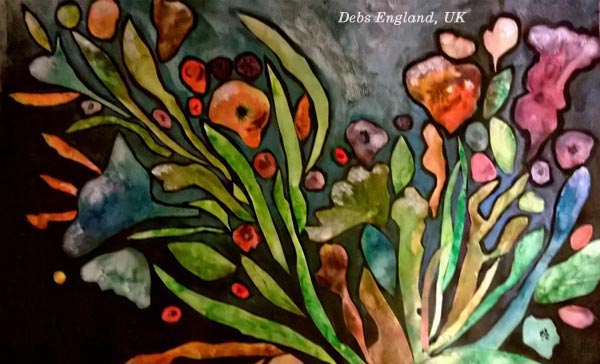
8) Blue Escape
Wassily Kandinsky: “The deeper the blue becomes, the more strongly it calls man towards the infinite, awakening in him a desire for the pure and, finally, for the supernatural… The brighter it becomes, the more it loses its sound, until it turns into silent stillness and becomes white.”
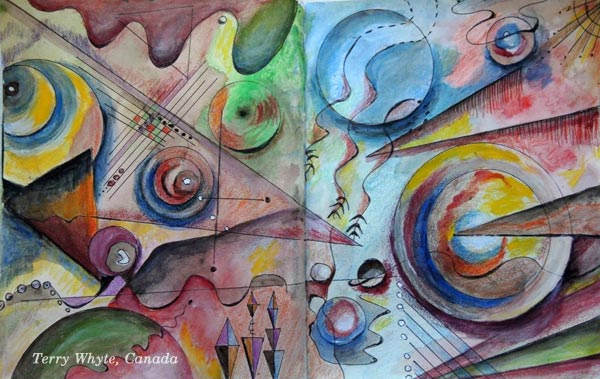
9) Nature’s Mystery
Francis Bacon: “The job of the artist is always to deepen the mystery.”
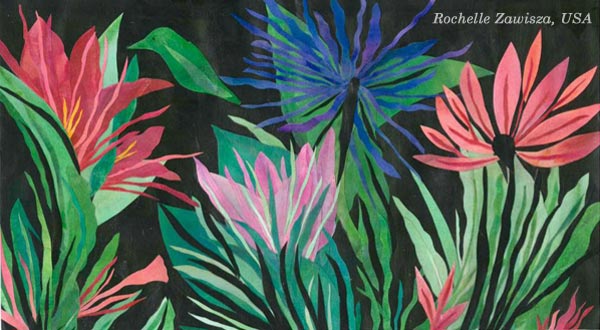
10) Colors of the Night
Vincent van Gogh: “I often think that the night is more alive and more richly colored than the day.”
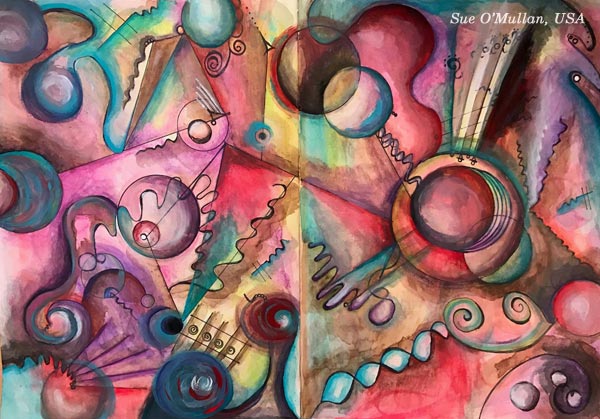
11) Strong but Gentle
Paul Klee: “One eye sees, the other feels.”
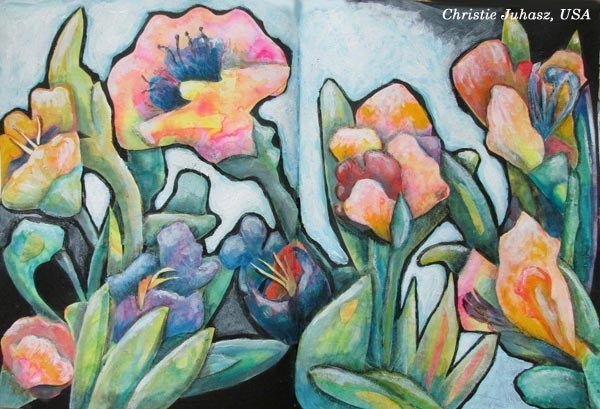
12) Explosion
M.C. Escher: “We adore chaos because we love to produce order.”
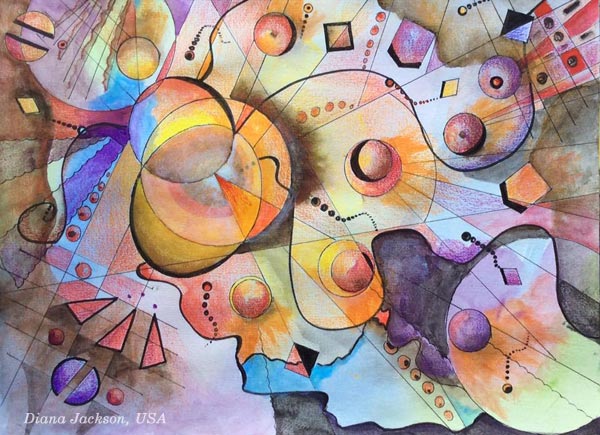
13) Panorama of Your Inner World
Wassily Kandinsky: “To create a work of art is to create the world.”
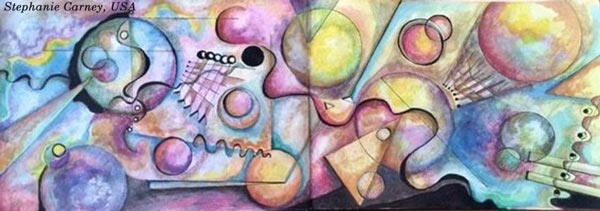
Buy Botanical Discovery!
Georgia O’Keeffe: “I decided that if I could paint that flower in a huge scale, you could not ignore its beauty.”
Botanical Discovery is a mini-course inspired by the famous American artist Georgia O’Keeffe and botanical art. Create beautiful collages from hand painted papers – Buy here!
Buy Romantic Geometry!
Wassily Kandinsky: “Everything starts from a dot.”
Romantic Geometry is a mini-course inspired by the famous abstract artist Wassily Kandinsky, Renaissance masters and computer games. It’s a journey through centuries and especially suitable for you who want to make your art more dynamic! – Buy here!
Let me be your art teacher: Subscribe to my weekly emails!

